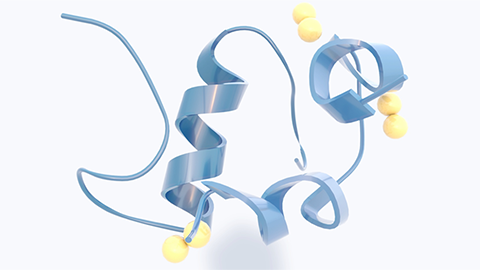Revealing the biology of insulin production
The discovery of insulin has saved the lives of millions of people with diabetes worldwide, but little is known about the first step of insulin synthesis.
Researchers at the University of Michigan have uncovered part of this mystery. Examining messenger RNAs involved in the production of insulin in fruit flies, they found that a chemical tag on the mRNA is crucial to translating the insulin mRNA into the protein insulin. The alteration of this chemical tag can affect how much insulin is produced.

The study, conducted by researchers Daniel Wilinski and Monica Dus, is published in the journal Nature Structural and Molecular Biology.
An organism carries DNA—its genes—in each cell of its bodies. Genes are blocks of information that get transcribed into proteins via another molecule called messenger RNAs. These mRNAs are photocopies of DNA—leaving the original DNA untouched—that ferry this protein information into the cytoplasm of cells, where protein is synthesized. The mRNAs are decorated with small molecules called “tags.” These tags can modify how RNAs function and how proteins are produced.
“I like to think of RNA as a Christmas tree,” said Wilinski, a postdoctoral researcher in Dus’ lab in the U-M Department of Molecular, Cellular and Developmental Biology. “Christmas trees are beautiful in the wilderness, but when you bring them inside and put ornaments on them, that decoration is what makes you feel like the tree is part of the season. Same thing with RNA. These decorations on RNA really enhance the way RNA is regulated.”
Studying insulin production in humans or mammals is difficult. In humans, the pancreas is situated behind the liver. It doesn’t regenerate well, and it can’t be sampled in live subjects. But in flies, their insulin cells are actually in their brains, function like neurons, and are physically accessible to researchers. In fruit flies, the researchers looked at a tag called RNA N-6 adenosine methylation, or m6A.
To study the m6A tag, the researchers first identified the RNAs that have the tag. Then they labeled insulin cells with a fluorescent molecule, and used confocal microscopy to visualize how much insulin is produced by the insulin cell. They did this under two conditions: first, they knocked out the m6A enzyme, responsible for decorating the mRNA with m6A tags, in insulin cells. Second, they removed the m6A tags by using CRISPR, a technology used to edit DNA, to mutate the modified As.
In both cases, the flies’ ability to produce insulin was greatly reduced.
“We found that this photocopy of the DNA for insulin, this mRNA, had a specific tag that, when it is present, a ton of the insulin hormone is made,” said Dus, associate professor of molecular, cellular and developmental biology. “But without the signal, flies had much less insulin and developed hallmarks of diabetes.”
This chemical tag is conserved—or unchanged—in fish, mice and humans.
“So it’s likely that insulin production is also regulated through this kind of mechanism in humans,” Wilinski said. “There is an obesity and diabetes epidemic not just in the United States, but across the world. Our finding is another bit of evidence about how this disease happens.”
Dus says the discovery fleshes out the understanding of the biology of insulin and the physiology of diseases of energy homeostasis. Low levels of chemical tags have been observed in people with Type 2 diabetes. Restoring the levels of these tags may also help with combating diabetes and metabolic disease, she says.
“We have known about insulin as a treatment for a hundred years. We have discovered so much about how insulin is made,” Dus said. “But we know so little about the very basic molecular biology of insulin and how it is regulated. That’s why I think this work is important—it refocuses on insulin, the gene and all the things we still have to discover about it.”
This article was first published by the University of Michigan. Read the original.
Enjoy reading ASBMB Today?
Become a member to receive the print edition four times a year and the digital edition monthly.
Learn moreGet the latest from ASBMB Today
Enter your email address, and we’ll send you a weekly email with recent articles, interviews and more.
Latest in Science
Science highlights or most popular articles

Mapping proteins, one side chain at a time
Roland Dunbrack Jr. will receive the ASBMB DeLano Award for Computational Biosciences at the ASBMB Annual Meeting, March 7–10, just outside of Washington, D.C.

Exploring the link between lipids and longevity
Meng Wang will present her work on metabolism and aging at the ASBMB Annual Meeting, March 7-10, just outside of Washington, D.C.

Defining a ‘crucial gatekeeper’ of lipid metabolism
George Carman receives the Herbert Tabor Research Award at the ASBMB Annual Meeting, March 7–10, just outside of Washington, D.C.

The science of staying strong
Muscles power every movement, but they also tell the story of aging itself. Scientists are uncovering how strength fades, why some species resist it and what lifestyle and molecular clues could help preserve muscle health for life.

Bacteriophage protein could make queso fresco safer
Researchers characterized the structure and function of PlyP100, a bacteriophage protein that shows promise as a food-safe antimicrobial for preventing Listeria monocytogenes growth in fresh cheeses.

Building the blueprint to block HIV
Wesley Sundquist will present his work on the HIV capsid and revolutionary drug, Lenacapavir, at the ASBMB Annual Meeting, March 7–10, in Maryland.

